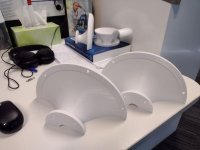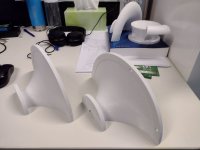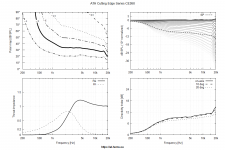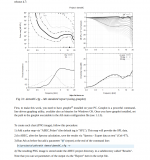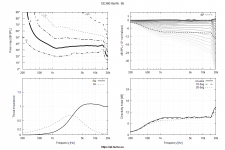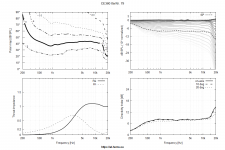Hi fluid,
Thank you,
M
The beamwidth is read off the -6dB line and is half the pattern angle in that graph. The waveguide is about 100 degrees at 1k and 80 degrees at 10K. It will match with a 12" Woofer over a reasonable range of frequencies.
Thank you,
M
Hi fluid,
Thank you,
M
The beamwidth is read off the -6dB line and is half the pattern angle in that graph. The waveguide is about 100 degrees at 1k and 80 degrees at 10K. It will match with a 12" Woofer over a reasonable range of frequencies.
Thank you,
M
I have two questions.
1) In the Tritonia release, parameter "Source" was define as this:
This seems to simulate a curved wavefront according to driver exit angle. And in the CE360 release simply defined flat, without any further tweaks:
The difference in simulation is the very high frequency behaviour. With a curved wavefront according to the first case, they fall off smoothly, with flat wavefront, they do peak. What to optimize for? What is correct?
2) I could not find "Rot" parameter, as shown in CE360 source code, in the current manual. What does it do?
1) In the Tritonia release, parameter "Source" was define as this:
Code:
Source.Shape = 1
Source.Curv = 0
Source.Radius = -1
Source.Velocity = 1
Code:
Source.Shape = 22) I could not find "Rot" parameter, as shown in CE360 source code, in the current manual. What does it do?
For a compression driver most are designed to produce flat wavefront, if the source is a dome or a CD intended to curve the wavefront then that would be the right choice.What to optimize for? What is correct?
2) I could not find "Rot" parameter, as shown in CE360 source code, in the current manual. What does it do?
Acoustic Horn Design – The Easy Way (Ath4)
Unless you know the actual exit wavefront of a driver used, none is more correct than the other. For 1" drivers this turned out to be almost irrelevant, as the higher order modes (i.e. any complexity of the source) seem to enter the picture sufficiently high in frequency for us not to bother much. For a 1.4" or 2" driver this would be a lot more important, but again, unless you know the truth, anything is just a guess and so it doesn't really matter, IMHO.[...] The difference in simulation is the very high frequency behaviour. With a curved wavefront according to the first case, they fall off smoothly, with flat wavefront, they do peak. What to optimize for? What is correct?
Last edited:
The only complaint I ever noticed when comparing good horn speakers (i.e. with controlled directivity) vs direct radiating designs myself, was always the "lack of spaciousness" of the horn speakers - there's the common phrase "giant headphones" expressing this phenomenon. To me this means that the room was still too dead for that kind of design, because I know it can sound different than that. Improve this aspect of the room and there will remain no reason why they should not be preferred - they're simply better in virtually everything else, if done right.Hi Marcel,
I am a little confused. Your first sentence expresses disagreement with Patrick's opinion that "people prefer speakers with a wider beamwidth", but the highlighted part of your second sentence implies that wide beam-width speakers are preferable since "more often" (antonym to very seldom), the acoustic condition are such that wide beam-width speakers could show their full potential.
Could you please clarify?
I hope this clarifies my position, however unimportant it is.
Last edited:
While it's definitely possible what Patrick suggests (i.e. to create a horn with varying length, coverage angle, etc.), I have yet to see one that would perform better than a "simple" axisymmetric waveguide in the end. It seems that the trick is not in the complexity but quite on the contrary. A pure spherical sound wave is pretty simple after all. And that's what we want, right?
- r when running ath command line after you crunched the viewer data in VACS but this is all in the manual provided. Look at the working example section.
You rock, thank you!
For anyone else who missed it, I've attached the instructions.
Attachments
Hi Marcel,
it does, thank you.
Kindest regards,
M
I hope this clarifies my position, however unimportant it is.
it does, thank you.
Kindest regards,
M
Did you happen to run an optimization on a waveguide like this with the target of a totally flat DI?I realized it doesn't really make sense to me to keep it secret, so here it is - the CE360.
I have only one request - please give credit where credit is due.
That's not how I do optimizations but I've quickly run a batch for what had a potential to result in a "flattish" DI - check it out, there's are some that could be built upon further (see the "Results/img" folder) - https://at-horns.eu/ext/CE360-Iterations.zip
I'm still only not sure it's better.
#79, #85 -
I'm still only not sure it's better.
#79, #85 -
Attachments
Last edited:
I'm still only not sure it's better.
Agreed, the jury is still out being as there is only scant evidence either way. I suspect the answer will be highly situation dependent, meaning that there isn't a single correct answer. I can envision situations where it would be better and some where it would be worse.
I worked tediously on a 50-degree pattern waveguide, this is the results so far:



I have not reached the smoothness of Marcel's work: Also removed turn-over from CE360 and put it on a baffle, some tweaking and this is what it looks like:

Both where scaled to the same diameter, 315 mm. I think this should be a good size for a waveguide on a 12-inch woofer baffle. Could be interchanged without changing the enclosure.



I have not reached the smoothness of Marcel's work: Also removed turn-over from CE360 and put it on a baffle, some tweaking and this is what it looks like:

Both where scaled to the same diameter, 315 mm. I think this should be a good size for a waveguide on a 12-inch woofer baffle. Could be interchanged without changing the enclosure.
Last edited:
- Home
- Loudspeakers
- Multi-Way
- Acoustic Horn Design – The Easy Way (Ath4)

